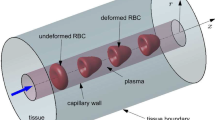Abstract
Oxygen transport from normal and sickle erythrocytes was studied under known and carefully controlled conditions simulating the microcirculation. Oxygenated erythrocyte suspensions became deoxygenated as they traversed silicone rubber capillaries of 27 μm diameter. Oxygen saturation values of the flowing erythrocyte suspensions were measured at several axial positions along the capillary by use of a microspectrophotometric technique. Oxygen saturation decreased with increasing distance from the entrance of the capillary and was strongly influenced by the flow rate. Under the same hematocrit and flow conditions, the rate of oxygen saturation decrease was significantly higher for the sickle cells than for normal cells. Sickle cells would be expected to have a higher diffusional resistance to oxygen transport than that of normal cells. However, the lower oxygen affinity of the sickle cells tends to increase the oxygen delivery rate. The difference in oxygen affinity appears to account for the difference in oxygen delivery rates between normal and sickle cells.
Access this chapter
Tax calculation will be finalised at checkout
Purchases are for personal use only
Preview
Unable to display preview. Download preview PDF.
Similar content being viewed by others
References
J.D. Hellums. “The Resistance to Oxygen Transport in the Capillaries Relative to that in the Surrounding Tissue”. Microvascular Research, 13, 131–136, (1977).
P.T. Baxley and J.D. Hellums, “A Simple Model for Simulation of Oxygen Transport in the Microcirculation,” Annals of Biomedical Engineering, 11, 401–416, (1983).
R.M. Bookchin and R.L. Nagel, “Molecular and Cellular Aspects of Red-Cell Sickling,” Contemporary Hematology/Oncology, Vol. 2, 3177, Edited by R. Silber et al., Plenum Publishing Co., (1981).
C.C. Winterbourn and R.W. Carrell, “Studies of Hemoglobin Denaturation and Heinz Body Formation in the Unstable Hemoglobins,” Journal of Clinical Investigation, 54, 678, (1974).
T. Asakura, K. Minakata, K. Adachi, M.D. Russell, and E. Schwartz, “Denatured Hemoglobin in Sickle Erythrocytes,” Journal of Clinical Investigation, 59, 633, (1977)
J.B. Scriver and T.R. Waugh, “Studies on a Case of Sickle Cell Anemia,” Journal of the Canadian Medical Association, 23, 375 (1930).
M.R. Becklake, S.B. Griffiths, M. McGregor, H.I. Goldman, and J.P. Schreve, “Oxygen Dissociation Curves in Sickle Cell Anemia and in Subjects with the Sickle Cell Trait,” Journal of Clinical Investigation, 34, 751, (1955).
T. Duhm, “Effect of 2,3-diphosphoglycerate and Other Organic Phosphate Compounds on Oxygen Affinity and Intracellular pH of Human Erythrocytes,” Pfluegers Archives, 326, 341, (1971).
P.A. Bromberg and W.A. Jensen, “Blood Oxygen Dissociation Curves in Sickle Cell Disease,” Journal of Laboratory and Clinical Medicine, 70, 480, (1967).
S. Charache, “Effect of 2,3-diphosphoglycerate on Oxygen Affinity of Blood in Sickle Cell Anemia,” Journal of Clinical Investigation, 49, 806, (1970).
Y. Ueda, R.L. Nagel, and R.M. Bookchin, “An Increased Bohr Effect in Sickle Cell Anemia,” Blood, 53, 472–480, (1979).
D.K. Kaul, R.L. Nagel, and S. Baez, “Pressure Effects on the Flow Behavior of Sickle (HbSS) Red Cells in Isolated (ex-Vivo) Microvascular Systems,” Microvascular Research, 26, 170–181, (1983).
H. Schmid-Schonbein, “Continuous Viscous Deformation of Red Blood Cells in Flow and Their Disturbance in Sickle Cell Disease,” Blood Cells, 8, 29–51, (1982).
R.P. Hebbel, O. Yamada, C.F. Moldow, H.S. Jacob, J.G. White and J.W. Eaton, “Abnormal Adherence of Sickle Erythrocytes to Cultured Vascular Endothelium: Possible Mechanism for Microvascular Occlusion in Sickle Cell Disease, ” Journal of Clinical Investigation, 65, 154, (1980).
P.P. Klug, N. Kaye, and W.N. Jensen, “Endothelial Cell_ and Vascular Damage in the Sickle Cell Disorders,” Blood Cells, 8, 175–184, (1982).
Hemoscan Oxygen Dissociation Analyzer, Operators Manual, Aminco, Division of Travenol Laboratories Inc., Silver Spring, Maryland.
E.J. Boland, H. Unno, J.S. Olson, and J.D. Hellunis, “An In-Vitro Method for Simulation of Oxygen Transport in the Microcirculation,” Oxygen Transport to Tissue-VI, 251–259, Edited by D. Brutey et al., Plenum Publishing Co., (1985).
E.J. Boland, J.D. Hellums, and J.S. Olson, “Development of an In Vitro Method for Simulation of Oxygen Transport in the Microcirculation,” Oxygen Transport to Tissue, Edited by F. Kreuzer, Plenum Publishing Co., in press.
H. Mizukami, H.G. Beaudoin, D.E. Bartnicki, and B. Adams, “Hysteresis-Like Behavior of Oxygen Association-Dissociation Equilibrium Curves of Sickle Cells Determined by a New Method (39659),” Proceedings of the Society for Experimental Biology and Medicine, 154, 304–309, (1977).
M. Sinet and J.J. Pocidalo, “Blood-Oxygen Affinity and Sickling in Sickle Cell Disease: Effect of Prior Deoxygenation,” Journal of Laboratory and Clinical Medicine, 98, No. 4, 492–499, (1981).
T. Kumpati, R.S. Franco, M. Weiner, and O. J. Martelo, “Sickling as a Function of Oxygen Delivery: Effect of Simulated Transfusions of Stored, Fresh and Isotol-Hexaphosphate-Loaded (Low Affinity) Red Cells,” Blood Cells, 8, 263–272, (1982).
D.G. Peters, J.M. Hayes, and G.M. Hieftje, “A Brief Introduction to Modern Chemical Analysis,” W.B. Saunders Co., (1976).
S.A. Berger and W.S. King, “Diffusion and Convection in the Capillaries in Sickle-Cell Disease,” Blood Cells, 8, 153–161 (1982).
R. Skalak, “Theoretical Models of Capillary Flow,” Blood Cells, 8, 147–152, (1982).
Author information
Authors and Affiliations
Editor information
Editors and Affiliations
Rights and permissions
Copyright information
© 1986 Plenum Press, New York
About this chapter
Cite this chapter
Stathopoulos, N.A., Hellums, J.D. (1986). Oxygen Transport Studies of Normal and Sickle Erythrocyte Suspensions in Artificial Capillaries. In: Longmuir, I.S. (eds) Oxygen Transport to Tissue VIII. Advances in Experimental Medicine and Biology, vol 200. Springer, Boston, MA. https://doi.org/10.1007/978-1-4684-5188-7_5
Download citation
DOI: https://doi.org/10.1007/978-1-4684-5188-7_5
Publisher Name: Springer, Boston, MA
Print ISBN: 978-1-4684-5190-0
Online ISBN: 978-1-4684-5188-7
eBook Packages: Springer Book Archive




